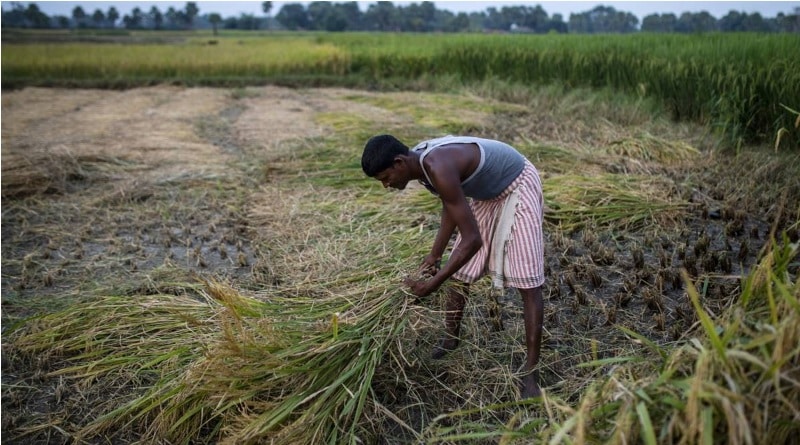What’s in today’s article?
- Why in news?
- Key highlights of the Survey with respect to Agriculture Sector
- Other highlights of Economic Survey 2023
Why in news?
- The Economic Survey 2022-23 said that the agriculture sector needs re-orientation given challenges like adverse impacts of climate change, fragmented landholdings and rising input costs.
Key highlights of the Survey with respect to Agriculture Sector
- Agriculture sector is growing at a robust annual growth rate
- The Survey noted that the Indian agriculture sector has been growing at an average annual growth rate of 4.6 per cent during the last six years.
- It grew by 3.0 per cent in 2021-22 compared to 3.3 per cent in 2020-21.
- The Survey noted that the Indian agriculture sector has been growing at an average annual growth rate of 4.6 per cent during the last six years.
- India emerged as the net exporter of agricultural products
- In recent years, India has rapidly emerged as the net exporter of agricultural products.
- In 2020-21, exports of agriculture and allied products from India grew by 18 per cent over the previous year.
- During 2021-22, agricultural exports reached an all-time high of $50.2 billion.
- Strong agri growth led to a YoY dip in monthly demand for MGNREGS
- There has been an Year-on-Year (YoY) decline in monthly demand for Mahatma Gandhi National Rural Employment Guarantee Scheme (MGNREGS) work.
- The number of persons demanding work under MGNREGS was seen to be trending around pre-pandemic levels from July to November 2022.
- In FY23, as on 24 January 2023, 6.49 crore households demanded employment under MGNREGS, and 6.48 crore households were offered employment out of which 5.7 crore availed employment.
- This is resulting from normalisation of the rural economy due to strong agricultural growth and a swift bounce-back from Covid-19.
- The significant growth in rural India, led by agriculture sector, was the major shock absorber during the COVID-19 pandemic.
- When majority of the workforce reverse-migrated to rural areas, agriculture as well as MGNREGA supported the domestic economy.
- The survey also credited the MGNREGS with having a positive impact on income per household, agricultural productivity, and production-related expenditure.
- It added that this helped with income diversification and infusing resilience into rural livelihoods.
- There has been an Year-on-Year (YoY) decline in monthly demand for Mahatma Gandhi National Rural Employment Guarantee Scheme (MGNREGS) work.
- Indian agriculture needs re-orientation
- The Survey highlighted that Indian agriculture needs re-orientation in the backdrop of certain challenges like adverse impacts of climate change, fragmented landholdings, sub-optimal farm mechanisation, low productivity, disguised unemployment, rising input costs, etc.
- The performance of the agriculture sector remains critical to growth and employment in the country.
Other highlights of Economic Survey 2023
- India’s green goals ambitious and needs money
- The Economic Survey emphasised India’s commitments for climate actions.
- However, it noted that availability of adequate and affordable finance remains a constraint for the country.
- India’s current priority is to grow economically and integrate development goals with climate action targets.
- India has so far largely met its requirements from domestic sources only.
- The survey said the country ranks third globally (after China and Australia) with respect to the net gain in average annual forest area between 2010 and 2020.
- It mentioned that the likely installed capacity by end of 2029-30 is expected to be more than 800GW.
- Of this, non-fossil fuel would contribute more than 500GW, resulting in the decline of average emission rate of around 29% by 2029-30, compared to 2014-15.
- The survey highlighted that India is progressively becoming a favoured destination for investment in renewables.
- During the period 2014-2021, total investment in renewables stood at $78. 1 billion in India.
Image Caption: India’s low carbon path
- Digital infrastructure can add 60-100 bps to GDP growth
- India’s digital public infrastructure (DPI) can add around 60-100 basis points (bps) to the country’s potential GDP growth rate.
- DPI includes platforms like Aadhaar, the Unified Payments Interface (UPI), and the account aggregator network.
- According to the Survey, payments made through UPI accounted for over half of all digital transactions in India in FY22 (2021-22).
- In FY22, UPI accounted for 52 per cent of the total 8,840 crore financial digital transactions with a total value of Rs 126 lakh crore.
- The Survey said that the country had a fintech adoption rate of 87 per cent among the public, compared to the global average of 64 per cent, making India the third biggest market for such transactions after the US and China.
- India’s digital public infrastructure (DPI) can add around 60-100 basis points (bps) to the country’s potential GDP growth rate.
Q1) What is Mahatma Gandhi National Rural Employment Guarantee Act (MGNREGA)?
The Government of India passed the Mahatma Gandhi National Rural Employment Guarantee Act, 2005 in September, 2005. The Act gives legal guarantee of a hundred days of wage employment in a financial year to adult members of a rural household who demand employment and are willing to do unskilled manual work.
Q2) What is Aadhaar?
Aadhaar is a 12 digit individual identification number which serves as proof of identity and proof of address for residents of India.
Source: Agriculture sector needs ‘re-orientation’ due to likely hurdles in climate change, surge in costs of inputs | The Hindu | Times of India
Last updated on December, 2025
→ Check out the latest UPSC Syllabus 2026 here.
→ Join Vajiram & Ravi’s Interview Guidance Programme for expert help to crack your final UPSC stage.
→ UPSC Mains Result 2025 is now out.
→ UPSC Notification 2026 is scheduled to be released on January 14, 2026.
→ UPSC Calendar 2026 is released on 15th May, 2025.
→ The UPSC Vacancy 2025 were released 1129, out of which 979 were for UPSC CSE and remaining 150 are for UPSC IFoS.
→ UPSC Prelims 2026 will be conducted on 24th May, 2026 & UPSC Mains 2026 will be conducted on 21st August 2026.
→ The UPSC Selection Process is of 3 stages-Prelims, Mains and Interview.
→ UPSC Result 2024 is released with latest UPSC Marksheet 2024. Check Now!
→ UPSC Prelims Result 2025 is out now for the CSE held on 25 May 2025.
→ UPSC Toppers List 2024 is released now. Shakti Dubey is UPSC AIR 1 2024 Topper.
→ UPSC Prelims Question Paper 2025 and Unofficial Prelims Answer Key 2025 are available now.
→ UPSC Mains Question Paper 2025 is out for Essay, GS 1, 2, 3 & GS 4.
→ UPSC Mains Indian Language Question Paper 2025 is now out.
→ UPSC Mains Optional Question Paper 2025 is now out.
→ Also check Best IAS Coaching in Delhi

















